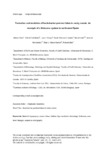| dc.contributor.author | Sáez, Alberto | |
| dc.contributor.author | Carballeira, Rafael | |
| dc.contributor.author | Pueyo Mur, Juan José | |
| dc.contributor.author | Vázquez-Loureiro, David | |
| dc.contributor.author | Leira, Manel | |
| dc.contributor.author | Hernández, Armand | |
| dc.contributor.author | Valero Garcés, Blas | |
| dc.contributor.author | Bao, Roberto | |
| dc.date.accessioned | 2024-03-12T20:30:46Z | |
| dc.date.available | 2024-03-12T20:30:46Z | |
| dc.date.issued | 2018-09-22 | |
| dc.identifier.citation | Sáez, A., Carballeira, R., Pueyo, J.J., Vázquez-Loureiro, D., Leira, M., Hernández, A., Valero-Garcés, B.L. and Bao, R. (2018), Formation and evolution of back-barrier perched lakes in rocky coasts: An example of a Holocene system in north-west Spain. Sedimentology, 65: 1891-1917. https://doi.org/10.1111/sed.12451 | es_ES |
| dc.identifier.issn | 1365-3091 | |
| dc.identifier.uri | http://hdl.handle.net/2183/35864 | |
| dc.description | This is an Accepted Article that has been peer-reviewed and approved for publication in the Sedimentology, but has yet to undergo copy-editing and proof correction. | es_ES |
| dc.description.abstract | [Abstract] Coastal back-barrier perched lakes are freshwater bodies that are elevated over sea-level and are not directly subjected to the inflow of seawater. This study provides a detailed reconstruction of the Doniños back-barrier perched lake that developed at the end of a small river valley in the rocky coast of the north-west Iberian Peninsula during the Holocene transgression. Its sequence stratigraphy was reconstructed based on a core transect across the system, the analyses of its lithofacies and microfossil assemblages, and a high-resolution radiocarbon-based chronology. The Doniños perched lake was formed ca 4·5 ka bp. The setting of the perched lake was favoured by Late Holocene sea-level stabilization and the formation of a barrier and back-barrier basin, which was contemporaneous with the high systems tract period. This basin developed over marine and lagoonal sediments deposited between 10·2 ka bp and 8·0 ka bp, during rapidly rising sea-level characteristic of the transgressive systems track period. At 1·1 ka bp, the barrier was breached and the perched lake was partially emptied, causing the erosion of the back-barrier basin sediments and a significant sedimentary hiatus. Both enhanced storminess and human intervention were likely to be responsible for this event. After 1 ka bp, the barrier reclosed and the present-day lake was reformed, with the water level reaching as high as 5 m above mean sea-level. The depositional evolution of the Doniños system serves as a model of coastal back-barrier perched lakes in coastal clastic systems that have developed over gently seaward-dipping rugged substrates at small distances from the shoreline and under conditions of rising sea-level and high sediment supply. A review of estuaries, back-barrier lagoons, pocket beaches and back-barrier perched lakes in the rocky coast of north-west Spain shows that the elevation of the bedrock is the main factor controlling the origin and evolution of these systems. | es_ES |
| dc.description.sponsorship | This study was funded by the Spanish Ministry of Economy and Competitiveness through the projects CONSOLIDER- Ingenio 2010 GRACCIE (CSD2007-00067), RapidNAO (CGL2013-40608-R) and PaleoMODES (CGL2016-75281-C2-1-R). AH and ML were supported by the Portuguese Science Foundation (FCT) through post-doctoral SFRH/BPD/79923/2011 and SFRH/BPD/82103/2011, respectively. RC is grateful for a PhD fellowship from the Xunta de Galicia (Plan I2C) co-financed by the European Social 94 Fund | es_ES |
| dc.description.sponsorship | Portugal. Fundação para a Ciência e a Tecnologia; SFRH/BPD/79923/2011 | es_ES |
| dc.description.sponsorship | Portugal. Fundação para a Ciência e a Tecnologia; SFRH/BPD/82103/2011 | es_ES |
| dc.language.iso | eng | es_ES |
| dc.publisher | Wiley | es_ES |
| dc.relation | info:eu-repo/grantAgreement/MEC/Plan Nacional de I+D+i 2004-2007/CSD2007-00067/ES/MULTIDISCIPLINARY RESEARCH CONSORTIUM ON GRADUAL AND ABRUPT CLIMATE CHANGES, AND THEIR IMPACTS ON THE ENVIRONMENT (GRACCIE)/ | es_ES |
| dc.relation | info:eu-repo/grantAgreement/MINECO/Plan Estatal de Investigación Científica y Técnica y de Innovación 2013-2016/CGL2013-40608-R/ES/RECONSTRUCCION DE LA NAO DURANTE LOS PERIODOS DE CAMBIO CLIMATICO RAPIDO DEL HOLOCENO/ | es_ES |
| dc.relation | info:eu-repo/grantAgreement/AEI/Plan Estatal de Investigación Científica y Técnica y de Innovación 2013-2016/CGL2016-75281-C2-1-R/ES/EL CLIMA HOLOCENO E IMPACTOS ECOLOGICOS DE LA INTERRELACION ENTRE EL PATRON DEL ATLANTICO ESTE (EA) Y LA OSCILACION DEL ATLANTICO NORTE (NAO) EN EL SUROESTE ATLANTICO EUROPEO/ | es_ES |
| dc.relation.uri | https://doi.org/10.1111/sed.12451 | es_ES |
| dc.rights | © The Authors | es_ES |
| dc.rights | © Sedimentology | es_ES |
| dc.rights | © International Association of Sedimentologists | es_ES |
| dc.subject | Bedrock topography | es_ES |
| dc.subject | Coastal lakes | es_ES |
| dc.subject | Galicia | es_ES |
| dc.subject | High-resolution chronology | es_ES |
| dc.subject | Holocene | es_ES |
| dc.subject | Sea-level changes | es_ES |
| dc.subject | Sequence stratigraphy | es_ES |
| dc.title | Formation and Evolution of Back-Barrier Perched Lakes in Rocky Coasts: An Example of a Holocene System in North-West Spain | es_ES |
| dc.type | info:eu-repo/semantics/article | es_ES |
| dc.rights.access | info:eu-repo/semantics/openAccess | es_ES |
| UDC.journalTitle | Sedimentology | es_ES |
| UDC.volume | 65 (2018) | es_ES |
| UDC.issue | 6 (October) | es_ES |
| UDC.startPage | 1891 | es_ES |
| UDC.endPage | 1917 | es_ES |
| dc.identifier.doi | 10.1111/sed.12451 | |






